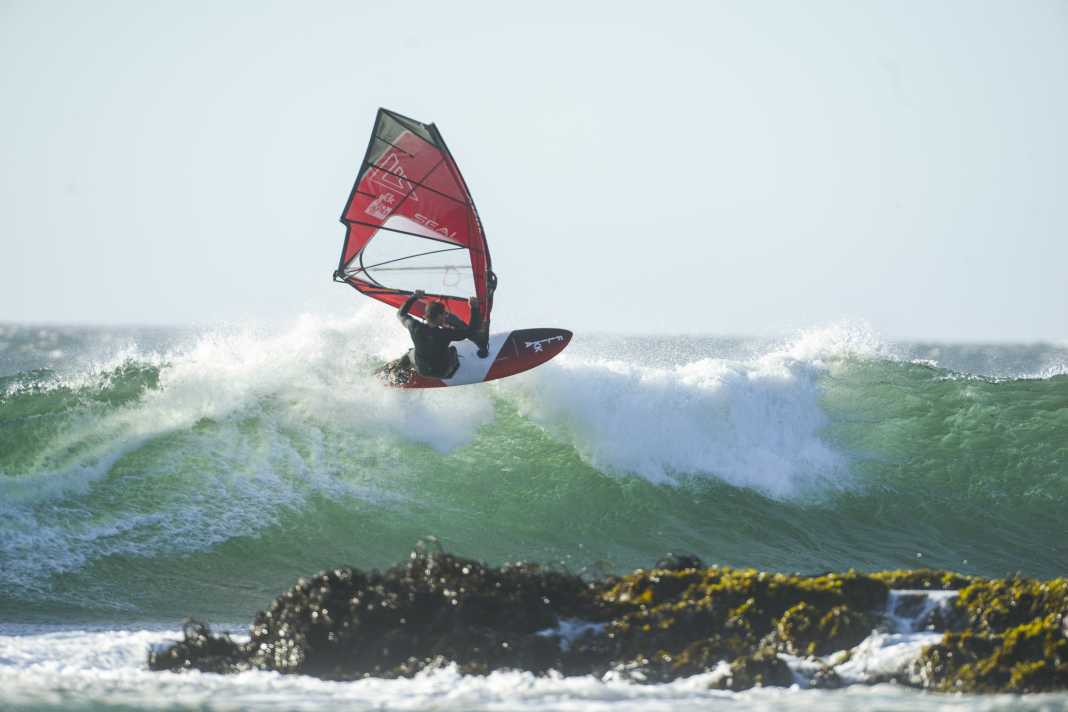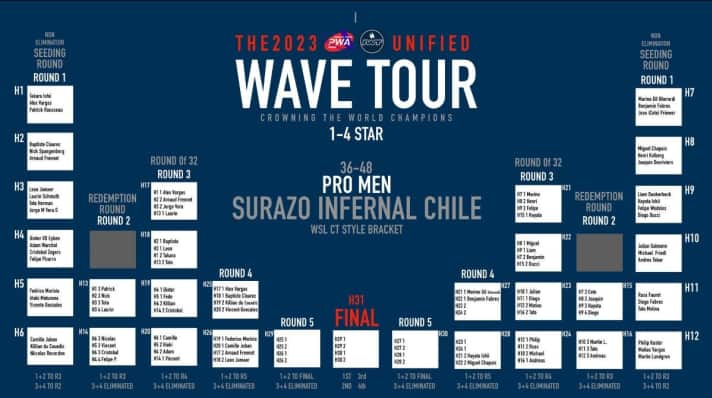IWT/PWA Topocalma: Behind the scenes at the Chile World Cup - Leon Jamaer reports






The four-star Surazo Infernal Chile, the second top event of the now combined IWT and PWA Wave Tour, kicked off directly after the opening competition in Japan at the end of March. While Japan is considered a five-star competition and the points therefore count 100 per cent towards the annual ranking, the placings from the four-star event in Chile only count 40 per cent. So if you win in Chile, you only get as many points as a twelfth place in a five-star competition. Anyone who expected a weak field of riders in Chile due to the low prize money and the few points awarded was wrong!
Top international riders in Chile
The prospect of an international wave competition in the premium conditions that Chile is known for not only motivated five-time world champion Philip Köster to sign up, but also attracted a top international line-up to the Pacific coast: Takara and Hayata Ishii from Japan, Baptiste Cloarec and Camille Juban from France and Guadeloupe, Canarios Gil Marino, Julian Salmonn, Liam Dunkerbeck and Belgian newcomer Dieter van der Ecken. In addition to Philip and Julian, the youngsters Henri Kolberg, Nick Spangenberg and Laurin Schmuth have also travelled with me from Germany. The women's field is much smaller. Australian Jane Seman will be competing against locals such as German-born Björte Pürschel and Carolyne Vita.
The strong field of riders and a good wind and wave forecast will make wave fans' hearts beat faster - finally a World Tour competition with down-the-line conditions and wind from the left! The last time this happened was in Brazil in 2007. Since then, the professional windsurfing sport has missed it rather sorely.
Enthusiasm vs. professionalism
The IWT aims to close precisely this gap in windsurfing in the waves. According to tour director Simeon Glasson, they are closer to surfing than sailing. The focus of the events organised by the IWT is therefore more on riding waves and less on jumping. "It's about channelling the joy and stoke we all feel when windsurfing in the waves into an event and bringing people together in one place," says Simeon, who wears other hats here as Head Judge and Media Coordinator and, to top it all off, also competes in the Masters division on the water. But isn't it also about organising an international competition professionally and finding the best wave windsurfers in the world?
Isn't it also about organising an international competition professionally?
Henri, Laurin, Nick and I are irritated when the event is renamed from Topocalma Infernal to Surazo Infernal at short notice. Instead of the dream spot of Topocalma, the competition is now to be organised directly in front of the Surazo Hotel in Matanzas. On day one, long after the registration deadline, more riders sign up and bring the "Dingle Elimination" draw (Contest format without a losers' round, but with an extra round for the losers of the first heats, editor's note.) are really mixed up. Suddenly Jorge, Philip Köster's caddy and notorious for his perfect goiters, is the fourth man in the heat together with Laurin and me, which doesn't necessarily make life any easier for us. Simeon's announcements about the course of the competition are neither punctual nor as precisely worded as we are used to from the PWA. There is no green flag to signal that the competition is underway - only a yellow one.

Let the games begin
The storm that Boris Hermann and Team Malizia are benefiting from as they race to catch up around Cape Horn during the Ocean Race is pushing large waves along the Chilean coast. But the wind doesn't play ball despite a reasonable forecast. We have to be patient for a few days and just as the hope of the dreamed-of down-the-line conditions is almost fading, the yellow flag for the first Pro Heats finally goes up!
The wind picks up at midday and clean two-metre-high waves roll into the bay of Matanzas, which is framed by rocks. The waves become steep upwind directly in front of the rocks - several turns can already be made here on the set waves. However, the wind is very unstable here due to the wind cover of a large dune.
In the first heat, local Alex Vargas shows how to deal with these difficult conditions: deep bottom turns, hard carves and routine airs all the way to the beach! The conditions in Matanzas become more and more challenging and the competition gets rolling. There are 18-minute heats with a two-minute transition time. The best two riders in each heat progress. As no jumps count, three judges can assess all four riders at the same time.
No second half, so mistakes are quickly penalised
While Henri makes it straight from round 1 to round 3, Laurin and Nick have to fight for survival in "Revenge Round" 2. Unfortunately, it's not enough for Nick to progress against strong locals. Laurin makes it through, but then doesn't have the best heat and is eliminated in round 3. One or a maximum of two lost heats mean the end of the competition in a dingle elimination. There is no second round. Henri puts in a solid performance in round 3 and shows what he has learnt in free riding in the days leading up to the competition: radical carves and airs in powerful sections. With little wind and now almost logo-high waves, Henri scores a beautiful air with seven points. Unfortunately, he catches the lip a little too late on his backup wave and is mercilessly penalised for the timing mistake.
In the meantime, hotshots Hayata Ishii and Gil Marino show that they are not only extremely good windsurfers at their home spots in Japan and Pozo, but also here in Matanzas. Original local and competition organiser Filipe Wedeles grabs one wave after the other and rides them with confidence. Despite a good performance, Henri ends up in fourth place in this round and thus in 25th place overall.
Matanzas continues to deliver
The conditions, which live up to the name of the event, last for two days so that the men's and women's pro divisions can be completed heat by heat. A total of three finals are held for the women, all of which are won by the experienced Jane Seman from Australia with powerful, fast wave rides.
In round three, I survived a tough heat against Takara and Baptiste and was then able to fight my way through to the semi-finals against Camille and Federico. My tactic is to wait for set waves and ride them from start to finish, just like Alex Vargas did with his first wave. Many locals and Julian do the same. Julian always impresses with fluid wave rides and a good mix of powerful turns, late airs and radical manoeuvres. Riders like Camille, Baptiste and Philip, on the other hand, show a lot of jumped tricks, such as Goiter and Air Taka, and tend to use smaller but steeper waves for this.
Two fundamentally different approaches to riding a wave meet here. However, it becomes clear early on that the judges favour the jumped tricks in critical parts of the wave. For me, this meant that in the semi-final I lost out to Baptiste and Camille in a close decision. On the other side of the draw, the Germans Philip and Julian will join the two Frenchmen in the final.
Debate about judging - the never ending story
In the 30-minute finale, the riders each remain true to their own style. Camille unwinds his entire repertoire of wave riding finesse. Philip succeeds in radical manoeuvres such as wave 360s, tweaked airs and takas - but sometimes he only manages one good manoeuvre per wave. Baptiste starts off with radical manoeuvres, but doesn't perform them as confidently as we are used to seeing from him. The aesthetic, well-timed wave rides with lots of flow from Julian impressed me personally the most. In the end, the judges see Philip in first place, Camille in second, followed by Julian and Baptiste - and thus remain true to their prioritisation of tricks over complete rides.
Philip has once again shown that he is the rider to beat in all conditions."
Without wanting to deny Philip his great performance - he once again showed that he is the rider to beat in all conditions - I think the opportunity could have been used here in Chile and the surfing criteria "speed, power, flow" could have been honoured more. It remains a judging debate that has to be held again and again and in the end remains subjective.
Few pictures, no livestream - the eternal budget problem
The IWT and Simeon Glasson, together with the organisers on site around the Surazo Hotel, managed to put on a wonderful competition with flying colours and thus made an important contribution to professional windsurfing in the waves. While the riders and organisers are still letting the successful results sink in, the rest of the windsurfing world is waiting for press releases, photos, videos...
Although uploading the images repeatedly fails due to the sporadic internet connection, Simeon is relaxed. The media budget for the event was low, and live streaming is out of the question. According to Simeon, the main thing is to put on a good show on site and have a good time together. The positive emotions of the participants and spectators will find their way and also reach and inspire the people in front of their screens. He is open to suggestions for improvement - however, the financial resources available in sport are simply too small for large media contingents and topical coverage, and this is something we need to realise. When you consider that there was no official live stream even at the PWA World Cup on Sylt last year, you can only agree with him.
In Matanzas, however, there was great enthusiasm for the event. As a result, discussions are already underway on how to increase the prize money for next year and improve media standards.

